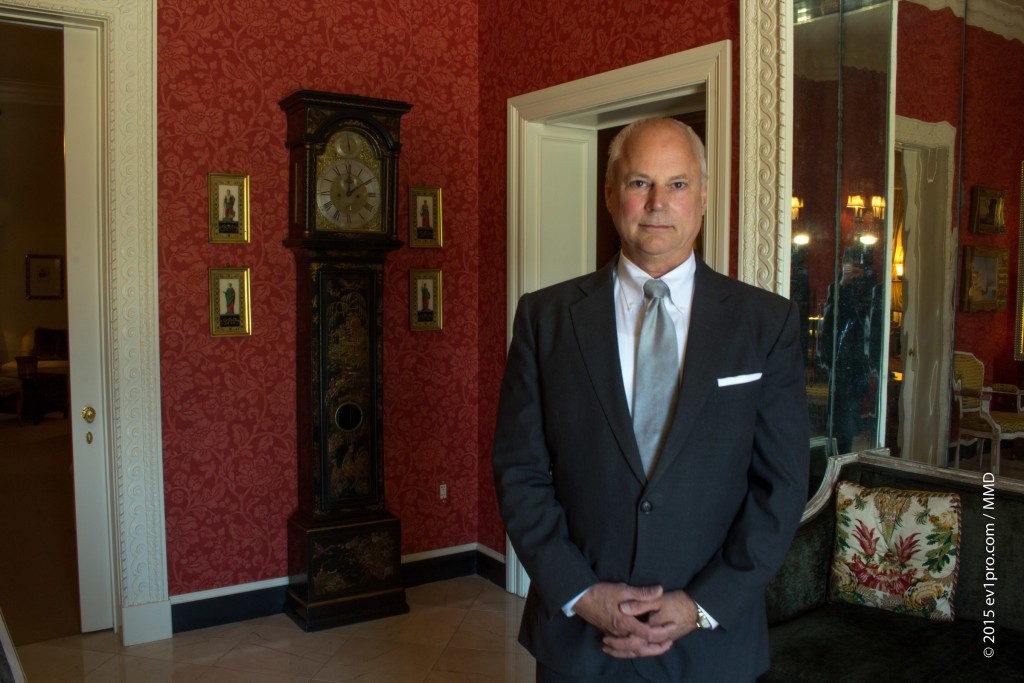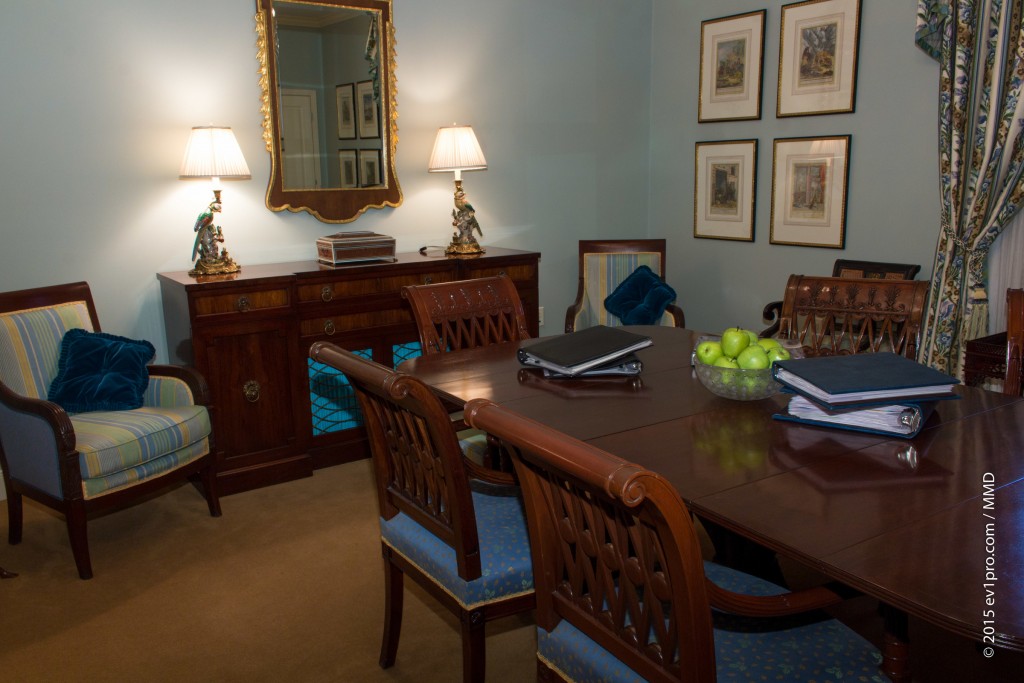At Home With Death: Bradshaw-Carter Strives For A Beautiful Goodbye

Open the door at Bradshaw-Carter Memorial & Funeral Services on West Alabama, and you might gasp. Inside this unremarkable brick building is a setting for saying goodbye like nothing else in Houston. A delectable scent of cinnamon skims the air. In the white marble foyer, a monumental 17th century Venetian table holds a Ming bowl filled with orchids. On one wall, a mercury mirror from the Renaissance bears a small painting of the Madonna brought from Turkey.
And beyond, instead of the shadowy, off-limits spaces that honeycomb many other funeral homes, light-filled rooms entice the senses even more. Among them: A vast gold salon accented with 19th century Chinese porcelains. A manly lounge with fireplace, wood paneling, and baskets made from antlers. A softly lit blue room with hand-carved chairs and wraparound murals of Italian gardens.
“People are amazed,” owner Tripp Carter says, leading the way to his office on the second floor. “They expect something cold and sterile. But it’s warm, it’s nurturing. No one is in a hurry to leave.”

In an industry that tries to send both the dead and the living on their way with top efficiency, Bradshaw-Carter is unique. Instead of making funerals somber and otherworldly, Bradshaw-Carter wants them to be homey, relaxing, and, above all, beautiful. In part, this is a throwback to the home funerals that were once the norm in America. It also borrows from the most humane death traditions of cultures around the world. And it reflects the singular artistic vision of Carter’s late partner, one-time interior designer Ron Bradshaw.
Carter, who now runs the business on his own, grew up a military child and went to Tulane, then worked in England at Sotheby’s before becoming a fundraiser for Rice University and the Menil Collection. Bradshaw, who died of pancreatic cancer in 2008 at the young age of 49, grew up in a middle-class Catholic family in Rhode Island, learning to love both funeral service and interior design. He memorized church liturgy, and when only five was already presiding over elaborate funerals for insects interred in matchbox caskets.
“He had a favorite uncle who lived with his family and had jaw cancer,” Carter says. “When his uncle died and was at the funeral home, he loved how the embalmers had made him look healthy again.”
After briefly attending funerary school, Bradshaw studied at the Fashion Institute of Technology in New York, where he gained attention for his European decorating aesthetic and his fashion designer’s way with fabric. With a staff of 35, and an unpretentious charm, Bradshaw became one of New York’s most sought-after interior designers – as well a social favorite with the moneyed women who were his clients. They were shocked, Carter says, when one morning Bradshaw woke up and said, “I’m not happy.” He wanted, he said, to learn the funeral business. So in the mid-1990s, while continuing to work as an interior designer, Bradshaw went back to school to complete his Mortuary Science degree.
In 1997 Bradshaw relocated his design offices to Houston, where his parents and sister lived. And gradually the fashion designer became a mortician, apprenticing at George H. Lewis and Sons funeral home, learning to embalm using the same finesse he had famously applied to window treatments. By 2003, Bradshaw was ready to open his own business.
“Do you think we could start our own funeral home?” he asked Carter, whom he had met and fallen in love with after arriving in Houston.
“Sure,” the then director of development for the Menil Collection replied. “I help make dreams become reality all the time.”
“He wanted to have the most beautiful funeral home in the United States,” Carter says. “Bradshaw-Carter is his gift.”

The heiress loved to gamble. So when her time came, Bradshaw-Carter delivered a funeral that honored her larger-than-life tastes. They hauled casino tables into the lounges, installed outsized pictures of the woman’s favorite racehorses, and made sure the Kentucky bourbon flowed.
And unlike most funeral homes, which conduct three or four funerals at a time, Bradshaw-Carter only holds one service a day, so the gamblers were under no pressure to leave. “People are stunned when they open the door – there’s music, a harp or piano, catering, wine,” Carter says. “They realize, ‘Oh, this is going to be a celebration.’ They relax, they meet people they know. Young people go into the study. People kick off their shoes. You get to experience the range of emotions without being rushed.”
In the eleven years they’ve been in business this way, Carter says, guests have never stolen any of the valuable decorations or damaged any of the surroundings. Occasionally, staffers will have to gently nudge them to go home. Midnight is usually the curfew. But otherwise, Bradshaw-Carter encourages leisurely leave taking. In late March, a Latino family requested the space from 9 a.m. to 9 p.m. to say goodbye to a grandfather. In one case, when a family lost a child, the funeral home set the casket in a small salon and permitted the mother to sleep on the couch for three days until she was ready for a service.
The idea, Carter says, is to offer a home – an exquisite, soothing home – for families to part from a loved one. “Ron used to say most funeral homes are hotels for the dead,” Carter recalls. At Bradshaw-Carter, even the space where funeral arrangements are made is designed as a dining room, with a glossy antique table and no computers or pamphlets to be seen. “Ron said most families make important decisions around a dining room table or a breakfast table,” Carter says. “We wanted it to be that way here.”

In the years when they were building the business, Bradshaw took this home-based approach to its furthest possibility. To finance the funeral home, the couple sold their painstakingly decorated condo and lived in a modest apartment next to the arrangements room. Soon, Bradshaw had plans for this space, too.
“I want to open an embalming service,” he announced. “In our kitchen.”
“Where are we going to eat?” Carter asked.
“We’ll go out,” Bradshaw replied.
Carter agreed, and the couple installed a surgical suite next to their living quarters. Their main client was MD Anderson, which needed embalming to send deceased patients to different parts of the country. For a year and half, accompanied by their shih tzu Henry, the couple would drive to the Medical Center, retrieve a body in their Mercedes van, and return to the house. Bradshaw carefully performed the embalming overnight. In the mornings, on the way to his job at the Menil, Carter calculated the invoices.
They ate out every night.
Today, Carter lives in a full-fledged apartment again, though one still contained in the building that houses Bradshaw-Carter. The funeral home now has an embalming suite and crematory, tastefully hidden behind a calligraphy sign reading “Private.” It all adds to the homey ethic. Families don’t have to buy a casket if they’re having a cremation: they can view the deceased on an antique daybed, then have the cremation on-premises. Instead of sending a loved one to be handled by strangers in different parts of the city, families can be close to everyone in the process.
Bradshaw-Carter’s slow approach makes a difference, says Genevieve Keeney, president of the National Museum of Funeral History.
“Psychologically, it’s really important for people to have the time to embrace the fact that their loved one is dead,” she says. “Sometimes if we can give them the choice to take the time that they need, they can have a healthier grieving process. If you think about it, a funeral is for the living. It’s a time for them to come together and show support for each other.”

Relaxing with the deceased at home is part of American tradition, Keeney adds. “We find comfort in our home,” she says. “Home is where the heart is. If you can create that environment that feels comfortable, where you can come together with family, and grieve and relax, there’s a lot to be said for that personalization. That’s how it was done back in the day. Embalming, posing, the funeral were done in the home. It creates a sense of comfort, of knowing who the person is that you’re entrusting with your loved one.”
Where most funeral homes have a chapel, Bradshaw-Carter has a garden room. “We thought chapels belong in churches,” Carter says. The soothing, pale blue room, with its hand-painted murals and hand-carved wooden chairs, is designed to focus all attention on the deceased and the relatives and friends who have come to grieve.
But Carter can’t resist pointing out his own touch embedded in the Italian gardens: a delicately rendered Texas Longhorn. “I had it painted in when Ron was out one day. When he saw it he asked me, ‘What did you do? You ruined my Italian garden!’” Carter recalls affectionately. “And I said, it’s Texas. We need a Longhorn.”
In fact, Carter says, every object in the house carries a personal story. On the second floor, a “grief library” offers sociology and history books about bereavement that guests may borrow. The books were chosen by Bradshaw, who read them all with a scholar’s attentiveness. Opening a cabinet below the bookshelf, Carter pulls out a broad, cloth-colored book from the 19th century, a catalogue of casket options. “Ron studied all of these images,” he says. “He studied everything about the industry.”
Even Bradshaw-Carter’s business style reflects the couple’s worldview. Carter – whose family was stationed in Japan when he was an infant, where he learned to speak Japanese before English – relishes the business’ appeal to other ethnicities and religions. “The Hindu and the Hare Krishna chanting is mesmerizing,” he says. “Once we had a casket out for visitation and were alone in the house, when we heard more chanting. We couldn’t figure it out, until we found the family had left a tape recorder playing Hare Krishna chants under the pillow in the casket.”

While the funeral home routinely pulls out the stops for its elite clients, it has always insisted on making funerals affordable. Sometimes they do them for free. “Ron didn’t grow up with money,” Bradshaw says. “We do funerals regardless of ethnicity, religion, sexual orientation, or ability to pay.” It’s a tradition at the home to provide infant funerals free of cost. As a result, Carter says, “we have 1,200 guardian angels looking down on us.”
A few years ago, a middle-aged man with a long, disheveled beard appeared in the marble foyer. He had been turned away at two other funeral homes, but he had promised to provide an appropriate funeral for his dear friend, a 25-year employee of Kroger.
“Can we play ZZ Top here?” he asked. “And Indian music? My friend is Native American.”
Carter and Bradshaw agreed at once. But when it came time for the paperwork, it turned out the dead man had no funeral insurance. “Lo and behold, he had never signed the papers Kroger gave him,” Carter says. Kroger offered to hold a fundraiser, but Bradshaw-Carter went ahead and held the funeral for free. “He had been at Kroger 25 years,” Carter says. “Everybody knew him.”
Heiress or bag checker, Carter says, Bradshaw-Carter believes that everyone deserves to depart life in a lovely home environment. Because this home was designed by Ron Bradshaw, it’s especially lovely. And because it remains an emotional home for Tripp Carter, he treats his clients like relatives.
“I can’t imagine myself doing anything else,” he says, carefully straightening a huge gold mirror on the salon wall. “People in the industry say, ‘You have to be the strong one.’ But I connect with these families, their stories, their music. So I cry with them too.”
